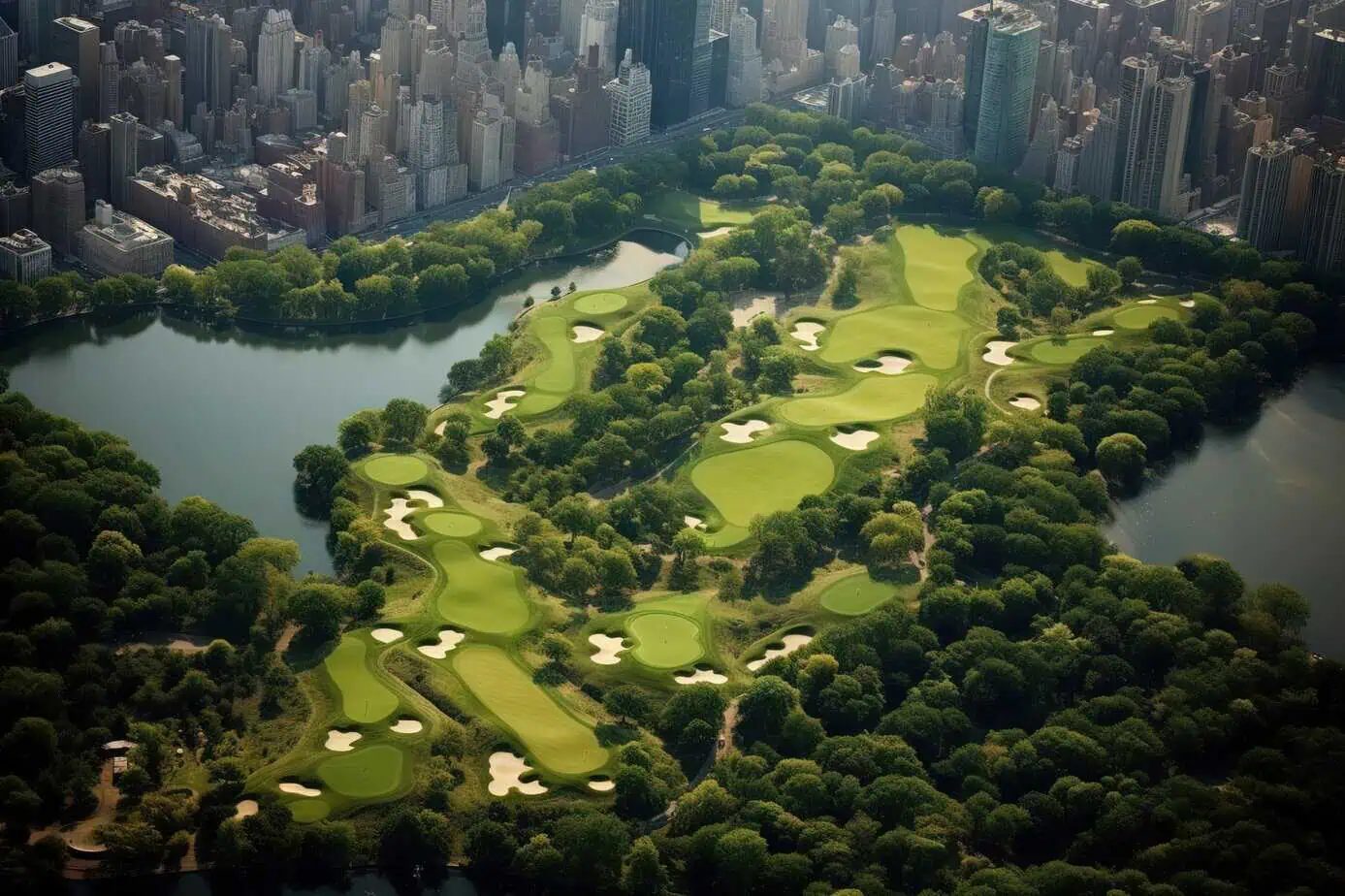What cooling effect do green spaces have during heatwaves? The study “The cooling effect of urban green spaces as nature-based solutions for mitigating urban heat: insights from a decade-long systematic review”, published in August 2025, shows how effective Urban Green Spaces (UGS) are as Nature-Based Solutions (NBS) for mitigating the Urban Heat Island (UHI). Based on the analysis of 84 scientific studies from the last ten years, the study shows that well-planned and well-maintained green spaces can reduce temperatures in cities by up to 7 °C. This study is therefore also relevant for golf courses that are located in areas close to cities and can draw important insights from the results for the structuring of their areas.
Initial situation: The growing urban heat island effect in cities worldwide
With global urban growth – over 56% of the world’s population already live in urban areas – heat pollution is increasing dramatically. Sealed surfaces made of asphalt and concrete store heat, block evaporation and promote overheating. Especially in hot and dry climate zones, water shortages and a lack of vegetation exacerbate the problem. The result: more hot days, increasing energy consumption for air conditioning and growing health risks.
Nature-Based Solutions in Europe: Climate adaptation with Urban Green Spaces
The European Commission is increasingly focusing on nature-based solutions to reduce climate risks and make cities more climate-resilient. Urban green spaces – from city parks and tree-lined avenues to green roofs – are a central element of this. They not only reduce temperatures, but also improve air quality, biodiversity and quality of life. The study shows that urban green spaces are an indispensable tool for modern climate adaptation
Which areas were examined – and which were not?
The studies analysed focused on a wide range of urban green structures: large city parks, street trees, smaller pocket parks, green squares, mixed areas of grass and shrubs as well as innovative solutions such as green roofs and vertical greening.
The areas studied did not include golf courses or other large-scale recreational areas. The results can therefore not be directly transferred to these types of areas, even if similar cooling mechanisms could theoretically be effective there. This is a shortcoming that particularly affects golf courses, which could have an important argument for their existence. After all, especially in large cities, there are repeated calls to close golf courses and use them for residential development.
Subscribe to our newsletter!
News & trends about sustainability in golf
Transferability of the results to golf courses
Golf courses differ from the urban green spaces examined in the study in several respects. They are generally larger, have a high proportion of open lawns and often have interspersed groups of trees, bodies of water and shrub areas.
- Cooling mechanisms such as shading are primarily effective on golf courses where trees and shrub areas provide shade – large fairways, on the other hand, offer hardly any shade.
- Evapotranspiration can be very high on golf courses due to extensive turf irrigation, which can lead to significant local cooling. However, this effect is highly dependent on the availability of water and the intensity of irrigation.
- Spatial arrangement: If golf courses are not located in the middle of densely built-up inner city areas, their contribution to mitigating the urban heat island in the city centre is lower. Nevertheless, they can be relevant for the local microclimate in the surrounding area, especially if they are adjacent to residential areas.
Golf courses can, therefore, generate similar cooling effects to urban green spaces, particularly through targeted tree planting and water features. However, the framework conditions differ significantly, meaning that the study’s results are only transferable to a limited extent.
The three main mechanisms of the cooling effect
The meta-study identifies three main mechanisms that determine the cooling effect of urban green spaces:
- Shading
Trees with dense crowns block direct sunlight, reduce surface temperatures by up to 16 °C and provide 2-7 °C cooler air locally. Crown density, tree height and choice of species play an important role here – evergreen trees provide year-round protection, deciduous trees provide seasonal peak cooling. - Evapotranspiration
Plants cool by releasing water through their leaves. This process can reduce air temperatures by 1-5 °C. Wide leaves, high leaf density and targeted irrigation increase the effect. In very dry climates, however, performance is limited without irrigation. - Optimal spatial arrangement
Interconnected green spaces, linear parks and green corridors channel cold air deeper into the urban area. Large, connected parks extend up to 500 m into the surrounding area.
What weakens the cooling effect
However, water shortages and a lack of irrigation hinder the cooling process just as much as the choice of wrong plant species with a small leaf area or low evaporation rate. In addition, the green areas should not be too small or too fragmented. This is also an argument in favour of golf courses, which generally offer green areas of at least 50 hectares with 18 holes.
The special role of plants in the cooling process
Trees are the undisputed stars among Nature-Based Cooling Solutions: they combine extensive shading with high evaporation performance. Mixed plantings of trees, shrubs and grasses maximize the effect. Species diversity also increases resistance to climate stress and ensures a year-round cooling effect.
However, this also means a difficult balancing act for golf course operators. After all, trees need water, and the shading of greens and tees, in particular, repeatedly leads to maintenance problems. It is therefore important to find the right mix here: Trees with low water consumption and high heat resistance should be planted. At the same time, the fairways must be planned so that there are no maintenance problems due to shading.
Golf courses or city parks?
Independent of the current study, scientists have already looked at the special cooling effects of golf courses in recent years and made comparisons with city parks. The latter usually have a stronger impact on the core of the urban heat island effect because they are closer to heat hotspots and have a high proportion of trees.
Golf courses therefore have great potential for cooling, especially through high evapotranspiration during irrigation. However, their effect on the urban climate depends heavily on location, vegetation structure and water resources.
If you would like to take a closer look at the topic, you will find a list of literature with research results here:
- Abd-Elmabod, S. K., et al. (2024). Seasonal variability of cooling services across urban green land-use types: Comparative assessment with parks, agriculture, and golf courses. Sustainable Cities and Society, 105, 105313. https://doi.org/10.1016/j.scs.2024.105313
- Fung, C. K. W., Jim, C. Y., & Song, C. (2017). Microclimatic effects of a subtropical golf course in an urban heat island. Urban Forestry & Urban Greening, 24, 1-13. https://doi.org/10.1016/j.ufug.2017.03.003
- Hamel, P., et al. (2021). Modeling the impact of land use change on urban ecosystem services: Insights from converting golf courses. npj Urban Sustainability, 1(1), 1-10. https://doi.org/10.1038/s42949-021-00025-8
- Lonsdorf, E., et al. (2021). Relative importance of different green space types for urban heat mitigation: An ecosystem services modeling approach. Landscape and Urban Planning, 209, 104043. https://doi.org/10.1016/j.landurbplan.2021.104043
- Nguyen, T. T., et al. (2022). Cooling performance of urban green spaces: A comparative analysis of land cover types in Perth, Australia. Remote Sensing, 14(9), 2094. https://doi.org/10.3390/rs14092094








 Photo: Four Seasons Hotel
Photo: Four Seasons Hotel